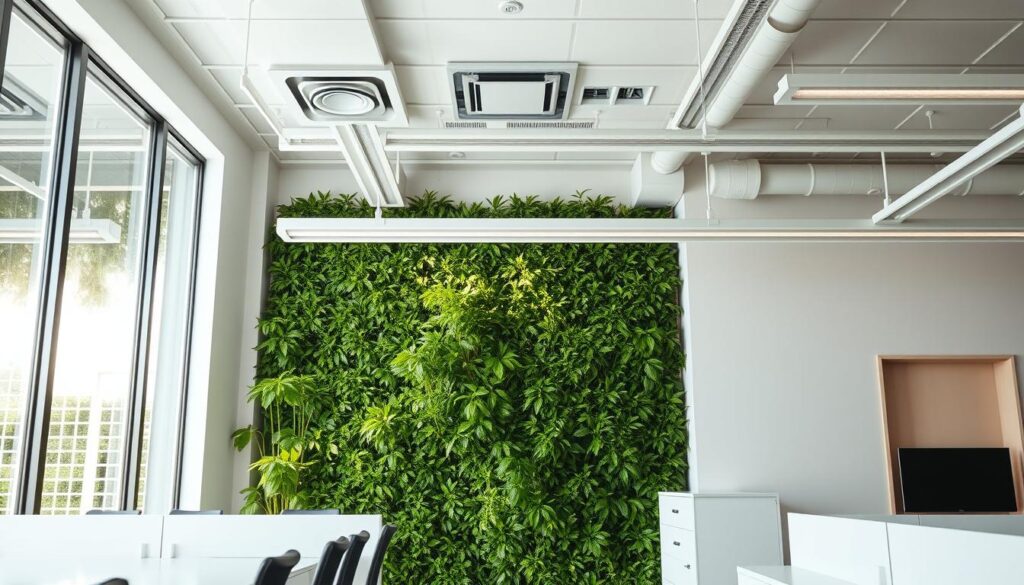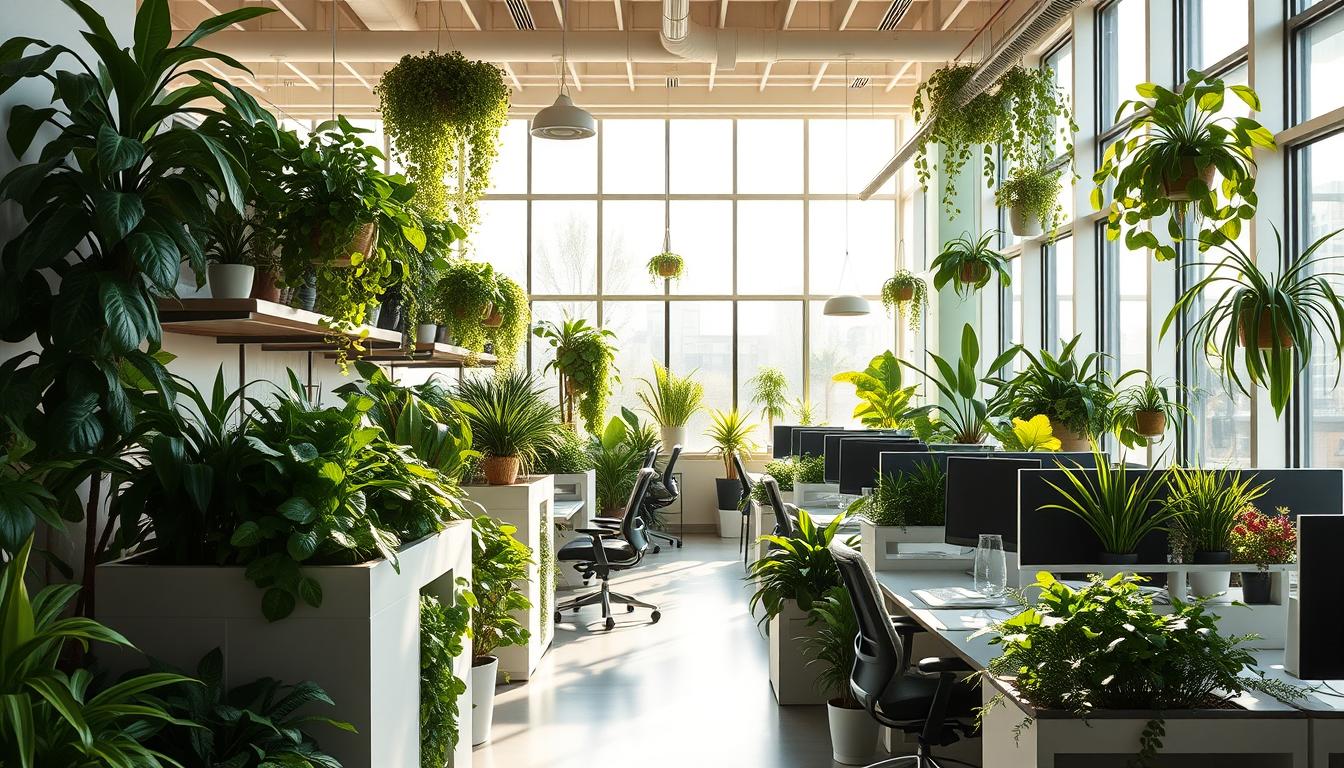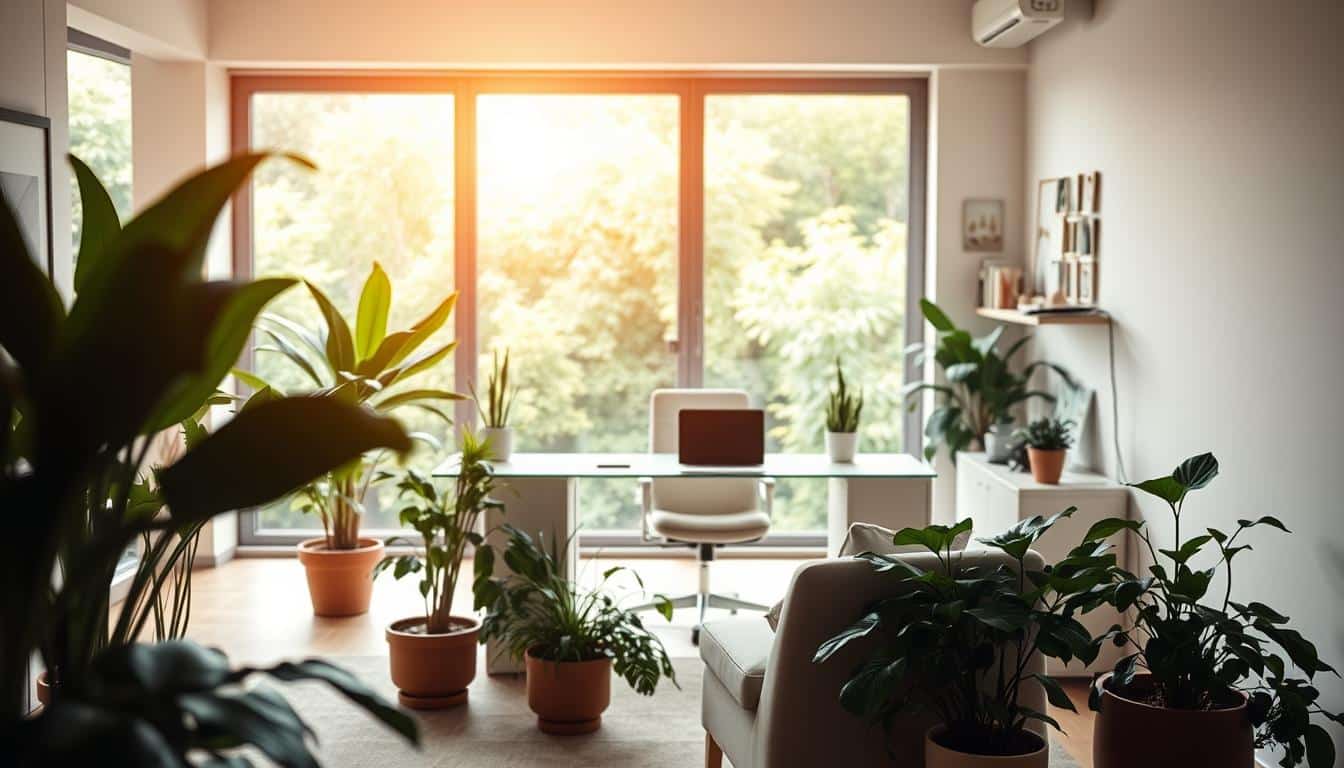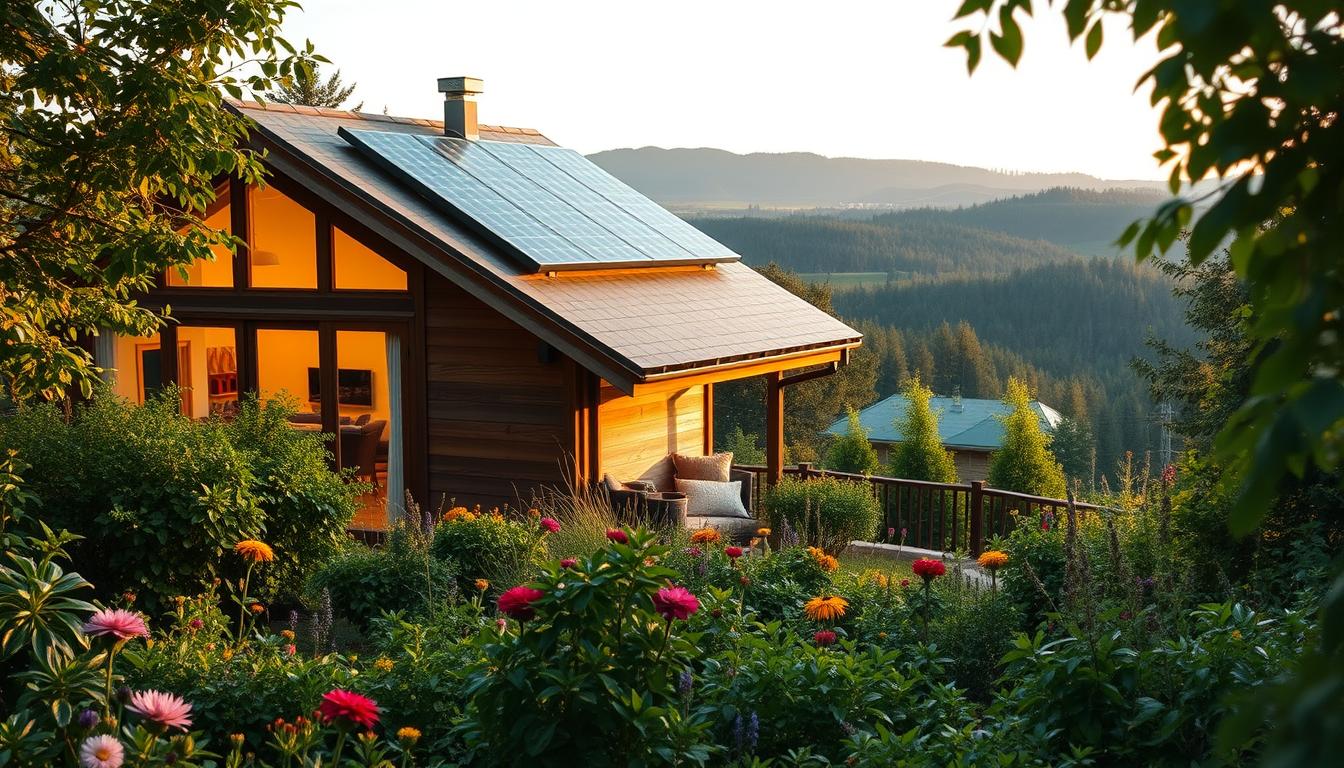Today, companies care more about employee health and productivity. They see office airflow mapping as key for a green office design. Adding plants can greatly improve air quality and make the office more welcoming. Recognizing how buildings and nature can work together leads to new ideas. These ideas improve the climate around us. This makes the office better for us and the environment.
Understanding the Importance of Office Airflow
Good airflow is key to a healthy workplace. It makes sure the air quality is good, which keeps employees healthy and productive. Having the right ventilation helps control humidity and brings in fresh air. This stops harmful pollutants from gathering.
Impact on Indoor Air Quality
Bad air quality in offices can harm health and comfort. When ventilation is poor, dust and pollutants can build up. This affects both physical and mental health.
Studies show that better airflow improves air quality. This cuts down on lung problems and boosts overall health. Good airflow keeps the office environment clean and good for work.
Effects on Employee Well-being and Productivity
Airflow matters a lot for work productivity. Offices with fresh air help employees focus better and feel more energetic. This leads to improved health, happiness, and work efficiency.
Companies focused on good airflow see happier and more productive teams. This proves that investing in office airflow pays off in work results.

What is Office Airflow Mapping?
Office airflow mapping studies how air moves inside buildings to make ventilation better and air quality higher. This helps make workspaces more comfortable and healthier. Knowing what airflow mapping definition is helps us analyze and control air better.
Definition and Purpose
The airflow mapping definition is about finding how air flows in a space and where it doesn’t move well. This mapping aims to adjust air movement so that clean air reaches people and reduces harmful particles. By analyzing the environment, we can make changes to improve air systems and the office setup.
Tools and Technologies for Airflow Mapping
To map airflow well, we use different airflow measurement tools. Ladybug software is one example. It helps us see environmental conditions and choose plants that fit green designs well. Another important tool is computational fluid dynamics (CFD) models. These models predict air movement around plants. This technology helps plan indoor spaces that are better for the environment.
Factors Affecting Office Airflow
The way air flows in offices depends on many things. The design and layout of the building are important, as well as the weather outside. Knowing about these can improve the air we breathe at work and make us more comfortable.
Building Design and Layout
The layout and design of a building help decide how air moves around. Where windows are, how rooms are divided, and how everything is arranged matters a lot. A good design helps air move freely, avoiding places where it might get stuck.
Environmental Conditions
What’s happening outside plays a big part in airflow inside an office. Things like the weather’s heat or cold, and how moist or dry the air is, change how air moves indoors. Cities can get hotter than the countryside, which messes up normal air movement. This shows why building design should consider these outside factors.
Benefits of Integrating Vegetation in Office Spaces
Adding plants to office spaces brings many advantages. They make the workplace look better and improve the air we breathe. Having plants around also makes employees feel good.
Enhancing Aesthetics and Employee Morale
Plants make offices look and feel nicer. They bring peace and help lower stress. Green spaces in the office can make employees happier. This leads to better job performance.
Natural Air Filtration and Cooling
Plants clean the air naturally. They take in carbon dioxide and pollutants, giving out fresh air. This helps everyone feel healthier. Plants can cool down the office too. This is really helpful in crowded places that get too warm.
Office Airflow Mapping with Vegetation
Adding plants to offices can make indoor air healthier and spaces more comfortable. Placing plants wisely can boost ventilation and create better air conditions at work. These methods improve air movement, helping everyone feel better and breathe cleaner air.
Role of Vegetation in Airflow Dynamics
Plants play a key role in how air moves in offices. They act as natural air cleaners, taking in bad air and giving out oxygen. This makes the air cleaner and the office a nicer place to be. The movement of air around plants helps spread cool, fresh air evenly.
Examples of Successful Implementations
Several examples show how plants can make office air flow better. The Illura Apartments in Australia is a shining example. It uses native plants to make indoor air nicer while also helping local nature. Such projects show that adding plants smartly can make offices greener and more pleasant.
Challenges in Implementing Vegetation in Workspaces
Adding plants to office spaces has many benefits but also comes with challenges. Knowing what problems might arise is key to keeping plants healthy and the office happy.
Maintenance and Care Requirements
Plants need regular care to do well in work areas. Things to keep an eye on include:
- Monitoring humidity and light levels
- Watering plants just right to avoid too much or too little water
- Fertilizing and repotting when necessary
Handling these care needs helps build a better work environment. It makes looking after indoor plants less of a hassle.
Potential for Allergens and Pests
Bringing plants indoors can raise concerns about allergies. Some plants might make pollen or other substances that could bother people. Choosing the right plants is important for employers. Helpful steps include:
- Opting for plants that are less likely to cause allergies
- Setting up ways to keep pests away
- Keeping the area clean to prevent allergens and debris
By keeping an eye on and handling these issues, the office space stays pleasant. It also supports everyone’s well-being.
Technologies for Monitoring Airflow and Vegetation
Technology has changed how we monitor indoor air and airflow in offices. Now, air quality monitoring tech helps us better understand and improve our surroundings. Thanks to these advancements, businesses can offer healthier places to work.
Indoor Air Quality Sensors
Indoor air quality sensors are key for a safe and comfy environment. Companies like Atmocube make sensors that track pollutants like VOCs and particulate matter. These environment sensors give updates in real time. This lets businesses adjust their HVAC systems quickly, avoiding bad air conditions. So, workplaces can stay healthy, meeting health standards and boosting worker productivity.
Computational Fluid Dynamics (CFD) in Vegetated Designs
CFD helps visualize airflow in green designs. It shows how air moves, helping architects design spaces that are good for the planet and people. With CFD, we can see how plants affect airflow. This can make the air better and workplaces nicer. These insights are essential for adding greenery to offices in a smart way, managing airflow well.
Best Practices for Optimizing Airflow with Vegetation
It’s key to use plants to make indoor air better for a healthier work area. The right plants can improve air quality and help them grow well. Choosing good plants and planning office layouts for better air movement are important.
Choosing the Right Plant Species
When picking plants for offices, we must consider a few things. These include:
- Local climate adaptability
- Humidity requirements
- Potential allergenic properties
Picking plants that fit these points helps improve air and makes the office nicer.
Designing for Optimal Airflow Circulation
How we design spaces for plants impacts air movement and our well-being. An effective design allows air to flow naturally by:
- Placing plants to help create paths for airflow.
- Putting plants in open areas, not tight corners.
- Using walls of plants to help with air movement.
This approach betters air quality and helps everyone feel better, showing the value of airflow in design.
Conclusion
Adding plants to office airflow plans is changing workspaces for the better. It makes air cleaner and helps employees feel and work better. Knowing how air and plants work together is key for designing healthier offices.
Using plants is more than making offices look good. It’s a smart move in building design that matches new trends. Learning about plants and airflow helps create offices that feel great and work well.
This new approach is shaking up the corporate world, turning offices into places where people do their best work. By mixing greenery with good airflow, companies are setting themselves up for success.



